
Mustafa İsmet İnönü was a Turkish army officer and statesman who served as the second president of Turkey from 11 November 1938 to 22 May 1950, and as its prime minister three times: from 1923 to 1924, 1925 to 1937, and 1961 to 1965.

The Turkish Armed Forces are the military forces of the Republic of Turkey. The Turkish Armed Forces consist of the General Staff, the Land Forces, the Naval Forces and the Air Forces. The Chief of the General Staff is the Commander of the Armed Forces. In wartime, the Chief of the General Staff acts as the Commander-in-Chief on behalf of the President, who represents the Supreme Military Command of the TAF on behalf of the Grand National Assembly of Turkey. Coordinating the military relations of the TAF with other NATO member states and friendly states is the responsibility of the General Staff.

The Turkish War of Independence was a series of military campaigns and a revolution waged by the Turkish National Movement, after parts of the Ottoman Empire were occupied and partitioned following its defeat in World War I. The conflict was between the Turkish Nationalists against Allied and separatist forces over the application of Wilsonian principles, especially national self-determination, in post-World War I Anatolia and Eastern Thrace. The revolution concluded the collapse of the Ottoman Empire; the Ottoman monarchy and the Islamic caliphate were abolished, and the Republic of Turkey was declared in Anatolia and Eastern Thrace. This resulted in a transfer of vested sovereignty from the sultan-caliph to the nation, setting the stage for Republican Turkey's period of nationalist revolutionary reform.

The Greco-Turkish War of 1897 or the Ottoman-Greek War of 1897, also called the Thirty Days' War and known in Greece as the Black '97 or the Unfortunate War, was a war fought between the Kingdom of Greece and the Ottoman Empire. Its immediate cause involved the status of the Ottoman province of Crete, whose Greek-majority population had long desired union with Greece. Despite the Ottoman victory on the field, an autonomous Cretan State under Ottoman suzerainty was established the following year, with Prince George of Greece and Denmark as its first High Commissioner.

The Battle of the Sakarya, also known as the Battle of the Sangarios, was an important engagement in the Greco-Turkish War (1919–1922).

Mustafa Kemal Atatürk, or Mustafa Kemal Pasha until 1921, and Ghazi Mustafa Kemal from 1921 until the Surname Law of 1934, was a Turkish field marshal, revolutionary statesman, author, and the founding father of the Republic of Turkey, serving as its first president from 1923 until his death in 1938. He undertook sweeping progressive reforms, which modernized Turkey into a secular, industrializing nation. Ideologically a secularist and nationalist, his policies and socio-political theories became known as Kemalism. Due to his military and political accomplishments, Atatürk is regarded as one of the most important political leaders of the 20th century.

The Turkish Land Forces, or Turkish Army, is the main branch of the Turkish Armed Forces responsible for land-based military operations. The army was formed on November 8, 1920, after the collapse of the Ottoman Empire. Significant campaigns since the foundation of the army include suppression of rebellions in Turkish Kurdistan from the 1920s to the present day, combat in the Korean War, the 1974 Turkish invasion of Cyprus and the current Turkish involvement in the Syrian Civil War, as well as its NATO alliance against the USSR during the Cold War. The army holds the preeminent place within the armed forces. It is customary for the Chief of the General Staff of the Turkish Armed Forces to have been the Commander of the Turkish Land Forces prior to his appointment as Turkey's senior ranking officer.

The Battle of Dumlupınar, or known as Field Battle of the Commander-in-Chief in Turkey, was the last battle in the Greco-Turkish War (1919–1922). The battle was fought from 26 to 30 August 1922 near Dumlupınar, Kütahya in Turkey.

The First Battle of İnönü took place between 6 and 11 January 1921 near İnönü in Hüdavendigâr Vilayet during the Greco-Turkish War (1919–22), also known as the western front of the larger Turkish War of Independence. This was the first battle for the Army of the Grand National Assembly that was newly built standing army in place of irregular troops.
The Second Battle of İnönü was a battle fought between March 23 and April 1, 1921 near İnönü in present-day Eskişehir Province, Turkey during the Greco-Turkish War (1919–22), also known as the western front of the larger Turkish War of Independence. It marked a turning point in the Greco-Turkish War and the Turkish War of Independence of which it was a part, as Greek forces had previously been victorious over mostly irregular Turkish forces and suffered their first major halt in Asia minor campaign.

Ali Fuat Cebesoy was an Ottoman and later Turkish army officer and politician.

Menemen is a municipality and district of İzmir Province, Turkey. Its area is 573 km2, and its population is 200,904 (2022). The district extends on a fertile plain formed by the alluvial soil carried by the Gediz River. Adjacent districts are, from east to west; Aliağa and Foça to the north and Bornova, Karşıyaka and Çiğli to the south. Menemen district has a 27 km (17 mi) long coastline in the west and neighbors Manisa Province to the east. The town of Menemen is located at a distance of 35 km (22 mi) from İzmir center. Settlement across the district is loosely scattered along the Greater Metropolitan Area of İzmir in the south and consists of isolated villages along prairies in the north, which results in an average urbanization rate of only 42 per cent. The economy still relies on agriculture and stock breeding in large part, although the production and export of leather, ceramic and other earthenware products, as well as potentially of plastic products, based in two separate and specialized organized industrial zones made important steps forward during the last decade. Menemen's earthenware pottery products have been famous across Turkey for centuries. These two organized industrial zones as well as activities rebounding from the adjacent İzmir metropolitan area gain an increasing importance in the district's economy. Nevertheless, Gediz River, whose lower basin crosses Menemen plain to join the sea within the district boundaries still constitutes the lifeline of the region and matters relating to the river's flow as well as its present rate of rather high pollution is a matter of constant debate.

Çiğli is a municipality and district of İzmir Province, Turkey. Its area is 139 km2, and its population is 214,065 (2022). It covers the northwestern part of the agglomeration of İzmir, around the mouth of the river Gediz, across the Gulf of İzmir from the main city. The Gediz delta is an Important Bird Area but is under threat from urbanization. IAOIZ, the Izmir Atatürk Organized Industrial Zone, is a significant economic hub and there is a major air force base.
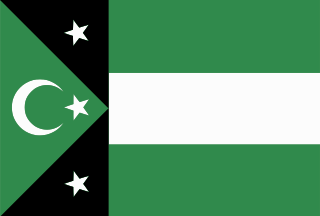
The Provisional Government of Western Thrace later Independent Government of Western Thrace, was a small, short-lived unrecognized republic established in Western Thrace from August 31 to October 25, 1913. It encompassed the area surrounded by the rivers Maritsa (Evros) in the east, Mesta (Nestos) in the west, the Rhodope Mountains in the north and the Aegean Sea in the south. Its total territory was approximately 8600 km2.
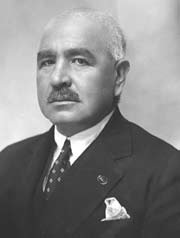
Ali Çetinkaya, also known as "Kel" Ali Bey was an Ottoman-born Turkish army officer and politician, who served eight terms in the Grand National Assembly of Turkey, including a period in 1939–40 as his country's first Minister of Transport.
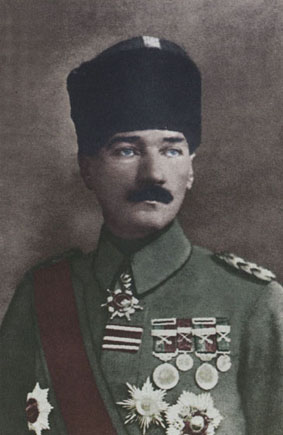
Mustafa Kemal Atatürk was a field marshal, revolutionary statesman, and founder of the Republic of Turkey as well as its first president. Mustafa Kemal Atatürk's military career explains his life between graduation from Ottoman War College in Istanbul as a lieutenant in 1905 to his resignation from the Ottoman Army on 8 July 1919, as well as his military leadership throughout the subsequent Turkish War of Independence.

The Kuva-yi Milliye were irregular Turkish militia forces active in the early period of the Turkish War of Independence. These irregular forces emerged after the occupation of the parts of Turkey by the Allied forces in accordance with the Armistice of Mudros. Later, Kuva-yi Milliye were integrated to the regular army of the Grand National Assembly. Some historians call this period (1918–20) of the Turkish War of Independence the "Kuva-yi Milliye phase".
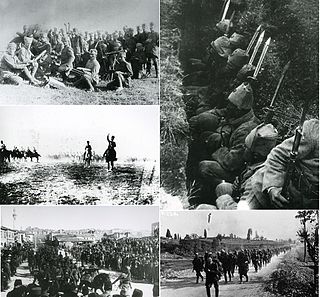
The Great Offensive was the largest and final military operation of the Turkish War of Independence, fought between the Turkish Armed Forces loyal to the government of the Grand National Assembly of Turkey, and the Kingdom of Greece, ending the Greco-Turkish War. The offensive began on 26 August 1922 with the Battle of Dumlupınar. The Turks amassed around 98,000 men, the largest number since the beginning of the war, to begin the offensive against the Greek army of approximately 130,000 men. From 31 August to 9 September, the front moved a distance of 300 km (190 mi) as the Greek troops retreated. The Turkish army lacked motorized vehicles; its forces consisted of infantry and cavalry units, and logistical support was provided by a supply system based on ox carts.
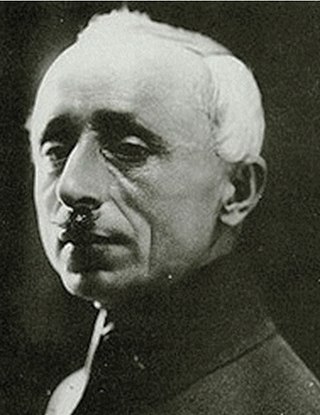
Refet Bele, also known as Refet Bey or Refet Pasha was a Turkish military commander. He served in the Ottoman Army and the Turkish Army, where he retired as a general.

The Greek Summer Offensive of 1920 was an offensive by the Greek army, assisted by British forces, to capture the southern region of the Sea of Marmara and the Aegean Region from the Kuva-yi Milliye of the provisional Turkish national movement government in Ankara. Additionally, the Greek and British forces were supported by the Kuva-yi Inzibatiye of the Ottoman government in Constantinople, which sought to crush the Turkish nationalist forces. The offensive was part of the Greco-Turkish War and was one of several engagements where British troops assisted the advancing Greek army. British troops actively took part in invading coastal towns of the Sea of Marmara. With the approval of the Allies, the Greeks started their offensive on 22 June 1920 and crossed the 'Milne Line'. The 'Milne Line' was the demarcation line between Greece and Turkey, laid down in Paris. Resistance by the Turkish nationalists was limited, as they had few and ill-equipped troops in western Anatolia. They were also busy on the eastern and southern fronts. After offering some opposition, they retreated to Eskişehir on Mustafa Kemal Pasha's order.


















